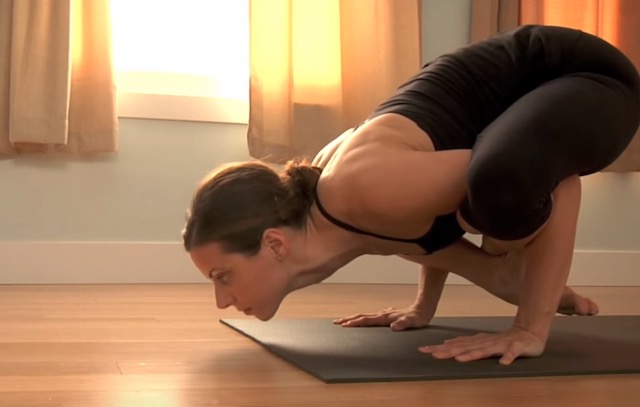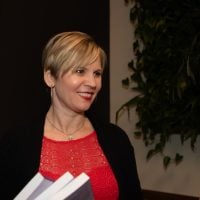
“Every Warrior of Light has, at least once, believed that he was not a Warrior of Light.” ~ Paulo Coelho
~
“Press both heels down into the earth. Backs of the heels root down into the mat. Engage the thigh muscles. Now, reach out!”
When teaching Downward Facing Dog, my first yoga teacher—trained by B.K.S. Iyengar, influenced by Judith Lasater, and inspired by Angela Farmer—implored us to not sink into our spines, but to create a long, beautiful line from our tailbones to our heads. She reminded us to keep the space open around our hearts, both back and front. She made sure we engaged the muscles around areas of weakness, such as hyperextended elbows and knees.
But first, she made sure we pressed our heels down firmly into the mat.
Only when grounded in this way would we inch forward with our hands, countering the additional reach with the strength and stability from our hips to our heels.
If our hamstrings would not allow our heels to reach the floor, we would place blocks beneath our hands. Or, for a true beginner, we would instead practice a Half Downward Dog, with our hands pressing into a wall at a 90 degree angle with our torso.
The alignment she insisted on in her classes was non-negotiable. We used blocks, straps, walls, and blankets to meet the criteria. The end result was not that we each attained a magazine-perfect pose, but rather felt the true definition of an asana—both sthira (steadiness), and sukha (ease)—in our own bodies.
Though I studied with other teachers after her (many of whom were more lax with alignment), it is she who most strongly influenced my own teaching style. More importantly, maybe, it was she who triggered my search to find my own power and reclaim my voice. It was she who inspired me to “yoke”—the meaning of the yoga’s root word (yuj)—my body, mind, and spirit in service to the world. To do so, no matter how awkwardly I might begin.
As I continued to study yoga, my voice in the world grew incrementally stronger. I came to see that every single pose—from the simplest of seated postures to the most complicated twist—is merely a metaphor, a stand-in for a way of being in the world. In other words, a yoga pose is not an end in itself, but a tool for practicing how to engage, ground, notice, activate, support, open, let go, reach, extend, stand.
The poses equip us spiritual seekers with the means to engage in the world with our feet grounded, our shadows out of hiding, and our eyes open to the world around us. The poses, by showing us how to heal our individual pain, equip us to enter the heart of our collective pain to see what we can do to ease it.
Anytime we need refueling, the practice mat is our home base where we can realign our bodies with our hearts, and clean up and sharpen our spiritual tools. Then, we can return to whichever field of battle calls to us.
And we are called.
We are called to be spiritual warriors. Called to speak out for those who have no voice. Called to protect those who can’t protect themselves. Called to stand up, like we do in a Mountain Pose, for what we won’t take lying down. We were never meant to remain in that safe, sweet, peaceful place of a yoga studio or meditation hall, away from the world and hidden from its pain.
Arjuna, the hero of the Bhagavad Gita, would be the first to agree that engagement is overwhelming, uncomfortable, and often painful. When he finds himself on a battlefield, he implores upon Krishna:
“As I see my own kinsmen, gathered here, eager to fight, my legs weaken, my mouth dries, my body trembles, my hair stands on end, my skin burns, the bow Gandiva drops from my hand, I am beside myself, my mind reels.”
Krishna, patient but direct with Arjuna, reminds him over and over again of his duty.
“Know what your duty is,
and do it without hesitation.”
Krishna also addresses Arjuna’s fear that his actions will prove unfruitful:
“Without concern for results,
perform the necessary action;
surrendering all attachments,
accomplish life’s highest good.”
Like many of us, I sometimes feel the urge to turn away from it all. I think maybe I should focus my attention, and my writings, exclusively on positive, optimistic, and high-minded messages, people, and events. I occasionally wonder if I should make it my personal mantra to not post anything online about politics, or talk about politics with anyone with whom I might disagree, or not let myself get roused about politics. I’ve seen plenty of spiritual teachers and practitioners do and suggest just these things. But if that’s not the height of privilege, what is?
Consider this: if one’s skin is any other color than white, one does not have a choice whether or not to confront racism. If one practices Islam, one cannot turn away from the impact of Islamophobia. If one is gay, one does not have a choice about whether to face homophobia. If one is a woman, she cannot escape sexism, no matter where she goes.
So why, as spiritual practitioners, inclusive of all these groups and more, would we think inaction is a choice in the first place? It wasn’t a choice for Krishna. And it isn’t for us, either.
It is because of my teacher’s imparted wisdom, combined with my love of the Gita, that I have never been able to understand when spiritually-minded people say they don’t want to get in the mud of politics, or push back on a legal issue, or speak out in any kind of material or earthly fight. I hear some say that it’s more spiritual to let it go, to trust that the universe has a plan, or to believe in a higher purpose.
This “purpose trusting” is widespread throughout spiritual communities, and it’s only increased since the dramatic and traumatic election of Donald Trump. But there is no mystery. The reason he was elected was because too many of us did not speak out against the prejudice, fear, and hatred he embodies. Perhaps we too easily trusted that goodness would prevail. Perhaps we felt that we had no business shaping the politics of our world.
But if anyone has the skillset to be on the front lines of modern-day battles, leading with wisdom, compassion, and calm abidance, it’s a yogi.
If there’s anyone who understands that the shadows “out there” are truly “in here,” and thus must be faced, it’s someone who contemplates such things on a regular basis.
If anyone understands the slowly-and-then-all-at-once way that paradigms shift, it’s someone who has seen their own spiritual growth unfold in a similar way.
If there’s anyone who can bring more hope, love, and positivity into the world, it’s someone who breathes these things in on a regular basis. And so, we must exhale them, too. What’s not yogic is to hold them captive inside ourselves, like limited resources.
Spiritual practitioners should not only be involved in shaping the future of the world, we should be leading the shaping.
Our spiritual tools, shined up and hanging in the toolshed, only serve our ego. To serve others, we must put them to use. From imagination to manifestation, each of us must find how we can best participate outwardly, while maintaining both sthira and sukha inwardly. There are as many possibilities for participation as there are unique human beings.
I believe it’s possible that we need more enlightened beings scattered about the planet. But it’s undeniable that we need more conscious beings, acting as spiritual warriors, in every corner of the planet. Let’s not let being “spiritual” stop us from being among them.
Instead, let’s root our heels down, breathe in the present moment, and from this grounded, strong place, reach out into the world—this one right here—with our hearts wide open. Only then are we are truly practicing our yoga.
~
~
Author: Keri Mangis
Image: YouTube still
Editor: Callie Rushton
Copy Editor: Travis May
Social Editor: Leah Sugerman










Read 5 comments and reply